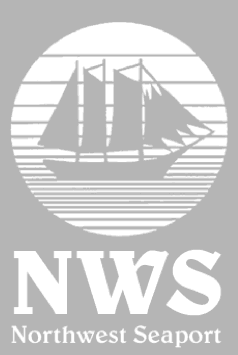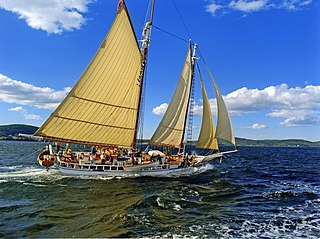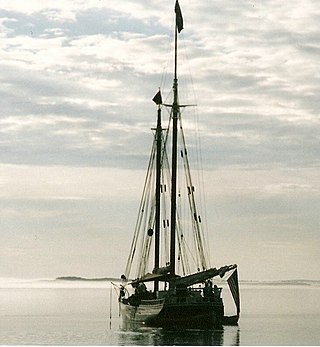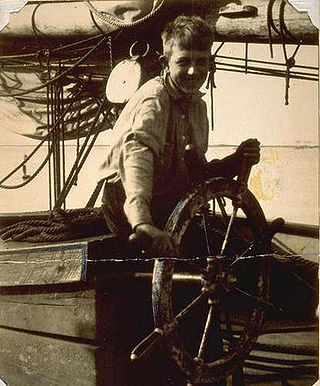
A pilot boat is a type of boat used to transport maritime pilots between land and the inbound or outbound ships that they are piloting. Pilot boats were once sailing boats that had to be fast because the first pilot to reach the incoming ship got the business. Today, pilot boats are scheduled by telephoning the ship agents/representatives prior to arrival.

Northwest Seaport Maritime Heritage Center is a nonprofit organization in Seattle, Washington dedicated to the preservation and interpretation of Puget Sound and Northwest Coast maritime heritage, expressed through educational programs and experiences available to the public aboard its ships. The organization owns three large historic vessels docked at the Historic Ships' Wharf in Seattle's Lake Union Park; the tugboat Arthur Foss (1889), Lightship 83 Swiftsure (1904), and the halibut fishing schooner Tordenskjold (1911). These vessels are used as platforms for a variety of public programs, ranging from tours and festivals to restoration workshops and vocational training.

C.A. Thayer is a schooner built in 1895 near Eureka, California. The schooner has been preserved and open to the public at the San Francisco Maritime National Historical Park since 1963. She is one of the last survivors of the sailing schooners in the West coast lumber trade to San Francisco from Washington, Oregon, and Northern California. She was designated a National Historic Landmark on 13 November 1966.

Effie M. Morrissey is a schooner skippered by Robert Bartlett that made many scientific expeditions to the Arctic, sponsored by American museums, the Explorers Club and the National Geographic Society. She also helped survey the Arctic for the United States Government during World War II. She is currently designated by the United States Department of the Interior as a National Historic Landmark as part of the New Bedford Whaling National Historical Park. She is the State Ship of Massachusetts.

Wawona was an American three-masted, fore-and-aft schooner that sailed from 1897 to 1947 as a lumber carrier and fishing vessel based in Puget Sound. She was one of the last survivors of the sailing schooners in the West Coast lumber trade to San Francisco from Washington, Oregon, and Northern California.

Zodiac is a two-masted schooner designed by William H. Hand, Jr. for Robert Wood Johnson and J. Seward Johnson, heirs to the Johnson & Johnson pharmaceuticals fortune. Hand intended to epitomize the best features of the American fishing schooner. The 160-foot-long (49 m), 145-ton vessel competed in transatlantic races. In 1931 the vessel was purchased by the San Francisco Bar Pilots Association, brought from the Atlantic, modified and placed in service as the pilot vessel California serving as such until retired in 1972.

Bowdoin is a historic schooner built in 1921 in East Boothbay, Maine, at the Hodgdon Brothers Shipyard. Designed by William H. Hand, Jr. under the direction of explorer Donald B. MacMillan, the gaff-rigged vessel is the only American schooner built specifically for Arctic exploration. She has made 29 trips above the Arctic Circle in her life, three since she was acquired by the Maine Maritime Academy as a sail training ship in 1988. She is currently owned by the Academy, located in Castine, Maine, and is named for Bowdoin College.

The schooner J. & E. Riggin, a National Historic Landmark, was built on the Maurice River in Dorchester, New Jersey in 1927. She is one of a small number of surviving two-masted schooners, once one of the most common sailing ships in North American waters. Now based in Rockland, Maine, she serves as a "windjammer" offering sailing cruises to tourists.

Adventure is a gaff rigged knockabout schooner. She was built in Essex, Massachusetts, USA, and launched in 1926 to work the Grand Banks fishing grounds out of Gloucester. She is one of only two surviving knockabout fishing schooners – ships designed without bowsprits for the safety of her crew.

Lettie G. Howard, formerly Mystic C and Caviare, is a wooden Fredonia schooner built in 1893 in Essex, Massachusetts, USA. This type of craft was commonly used by American offshore fishermen, and is believed to be the last surviving example of its type. She was declared a National Historic Landmark in 1989. She is now based at the South Street Seaport Museum in New York City.

L. A. Dunton is a National Historic Landmark fishing schooner and museum exhibit located at the Mystic Seaport Museum in Mystic, Connecticut. Built in 1921, she is one of three remaining vessels afloat of this type, which was once the most common sail-powered fishing vessel sailing from New England ports. In service in New England waters until the 1930s and Newfoundland into the 1950s. After a brief period as a cargo ship, she was acquired by the museum and restored to her original condition.

Emma C. Berry is a fishing sloop located at the Mystic Seaport Museum in Mystic, Connecticut, United States, and one of the oldest surviving commercial vessels in America. She is the last known surviving American well smack. This type of boat is also termed a sloop smack or Noank smack. The Noank design was imitated in other regions of the United States.

Grace Bailey, also known for many years as Mattie, is a two-masted schooner whose home port is Camden Harbor, Camden, Maine. Built in 1882 in Patchogue, New York, she is one of four surviving two-masted wooden-hulled schooners, once the most common vessel in the American coasting trade. She was one of the first ships in the fleet of historic vessels known as "Maine windjammers", which offer cruises in Penobscot Bay and the Maine coast, entering that service in 1939. She last underwent major restoration in 1989-90. She was declared a National Historic Landmark in 1992.

Isaac H. Evans, originally Boyd N. Sheppard, is a two-masted schooner berthed in Rockland, Maine. She is a Maine windjammer, serving the tourist trade. Built in 1886 in Mauricetown, New Jersey, she is the oldest of a small number of surviving oyster schooners, used in service of the oyster harvesting industry in the coastal waters of New Jersey. She was declared a National Historic Landmark in 1992.

Lewis R. French is a gaff-rigged topsail schooner sailing out of Camden, Maine as a "Maine windjammer" offering 3 to 6 night cruises to tourists. Built in 1871, she is the oldest known two-masted schooner in the United States, and one of a small number of this once-common form of vessel in active service. The ship was designated a US National Historic Landmark in 1992.

Stephen Taber is a two-masted schooner, built in 1871, operating as a "windjammer" in the tourist trade out of Rockland, Maine. A National Historic Landmark, she is one of a small number of surviving schooners originally built for the Atlantic coasting trade, and one of only three with a centerboard, allowing access through shallow channels and to shallow landing points. She is named for New York lawyer and politician Stephen Taber, and has a well-documented history of continuous service since her construction.

The three-masted schooner Victory Chimes, also known as Edwin and Maud or Domino Effect, is a US National Historic Landmark. She is the last surviving Chesapeake Ram schooner. The boat on the Maine State Quarter is meant to resemble the Victory Chimes.

John Faunce Leavitt (1905–1974) was a well-known shipbuilder, writer on maritime subjects, painter of marine canvases, and curator of Mystic Seaport in Mystic, Connecticut.
Dorothea Weber was a 190 GRT three-masted Schooner that was built in 1922 as the barge Lucy by J Oelkers, Hamburg. She was later renamed Midgard I, Midgard IV and then Elisabeth before a sale in 1935 saw her fitted with a diesel engine and renamed Dorothea Weber. She was seized by the Allies in May 1945 at Guernsey, passed to the Ministry of War Transport (MoWT) and renamed Empire Cononley.

The Cora F. Cressey was a five masted 273 feet (83 m) wooden-hulled freight schooner operating in the coasting trade along the east coast of the United States. Built in 1902, it served in that trade until 1928. After serving for a time as a floating nightclub, its hulk was towed to the Keene Narrows in Bremen, Maine, where it was scuttled to serve as a breakwater for a lobster operation. Despite its deteriorating condition, the hulk is one of the largest surviving wooden hulls in the United States. It was listed on the National Register of Historic Places in 1990.





















